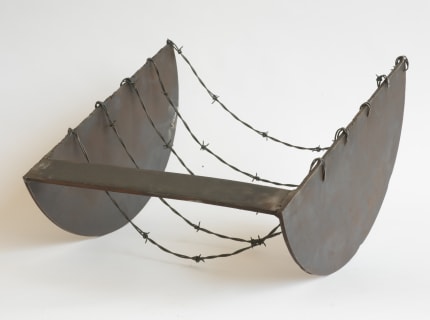Melvin Edwards possesses a thoroughly enlivening process mania. Looking at the disciplined repetition of the pieces on view at his indispensable retrospective at the Fridericianum—the raw firmness of the steel creates a shared aura between the 13 examples of the ‘Lynch Fragments’ and the freestanding sculptures, while the spray painted silhouettes echo the pattern of the barbed wire installations—I thought about the complicated intimacy that must exist between Edwards and his materials. Formed by welded scraps of metal, the familial resemblance of the small, intensely enigmatic wall reliefs comprising the ‘Lynch Fragments’ gives the impression that they were made in a single burst of creative energy. This is not the case. In fact, starting in 1963, after studying painting at the University of Southern California where he also took an introductory class in welding that transformed the path of his artistic practice, Edwards has worked on the ‘Lynch Fragments’ almost continuously for his entire career, with brief interruptions from 1967 to 1972 and from 1974 to 1977.
The smart arrangement of ‘Lynch Fragments’ in the museum’s first-floor rotunda makes two deeply connected aspects of Edwards’ art stand out in trenchant contrast. One is his resolute orientation toward the process of sculpture rather than the finality of the art work, and the other is his investigation of art’s capacity to come to a phenomenal understanding of historical violence while refusing the devices of representation. Edwards calls these heart-sized works of industrial detritus, which confront the visitor at eye-level, “fragments” for a good reason. With a work like ‘Some Bright Morning’ (the title refers to a story from Ralph Ginzburg’s ‘100 Years of Lynching’ about a Black family’s armed self-defense against a white mob), the term might suggest that this sculpture of mangled steel stands for a shattered and recombined piece of historical evidence—the accursed relic of a white supremacist attempt at extrajudicial murder. But the fragment of ‘Some Bright Morning’ is also a literary form. It gives a conditional credence to the idea that violence leaves an unrepresentable void in its wake, but establishes a preeminent place—like the messianic fragments of Walter Benjamin’s ‘Arcades Project’—for the lightning-brief glimpse of history through an eloquent framing of its ruins, the balance of blade-like triangular shapes against the gradual spillage of chain-link.
...
Read full review at berlinartlink.com.

